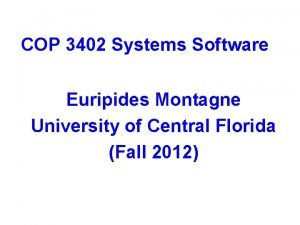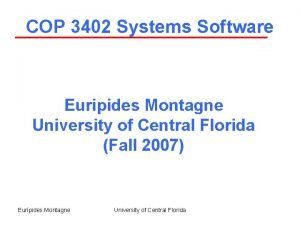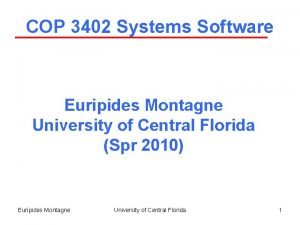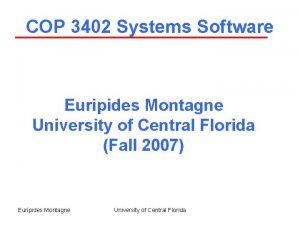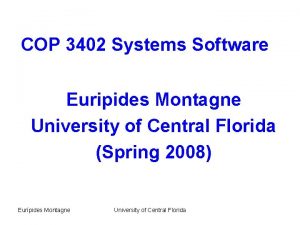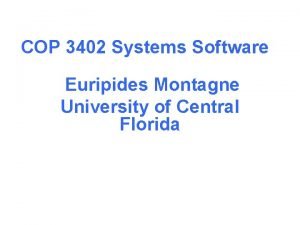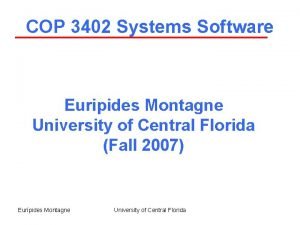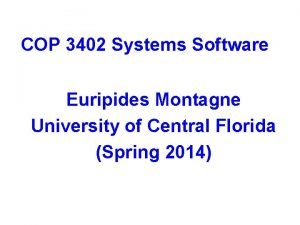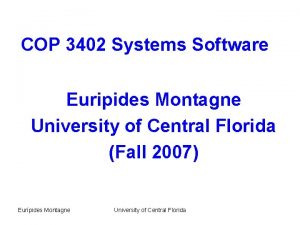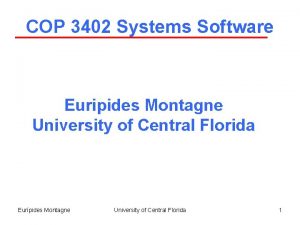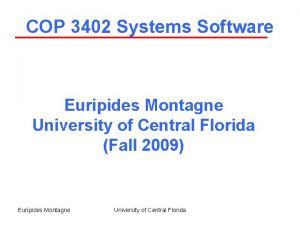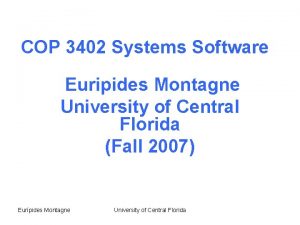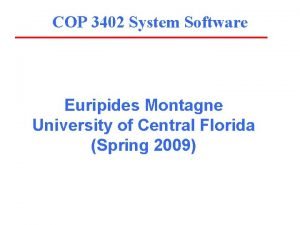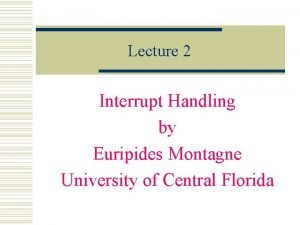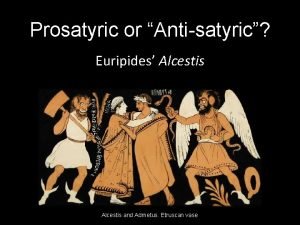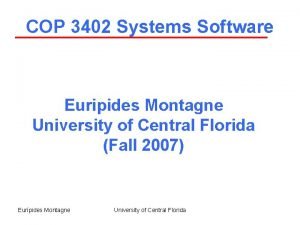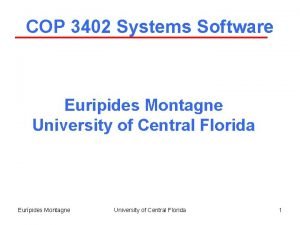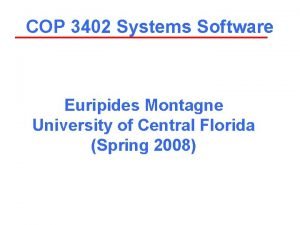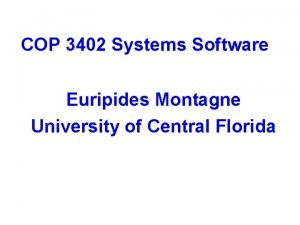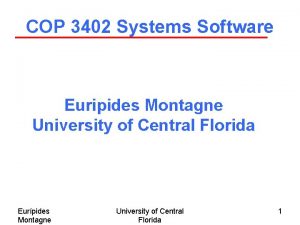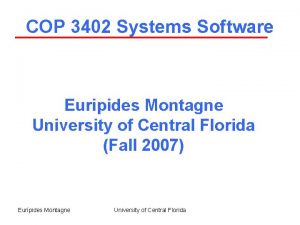COP 3402 Systems Software Euripides Montagne University of










![Extended BNF grammar for PL/0 (2) <expression> : : = [ "+"|"-"] <term> { Extended BNF grammar for PL/0 (2) <expression> : : = [ "+"|"-"] <term> {](https://slidetodoc.com/presentation_image/451a47c0145a33fda9df3f3acee72fb4/image-11.jpg)





- Slides: 16

COP 3402 Systems Software Euripides Montagne University of Central Florida (Fall 2007) Eurípides Montagne University of Central Florida

COP 3402 Systems Software Top Down Parsing (Recursive Descent) Eurípides Montagne University of Central Florida

Outline 1. The parsing problem 2. Top-down parsing 3. Left-recursion removal 4. Left factoring 5. EBNF grammar for PL/O Eurípides Montagne University of Central Florida

Recursive descent parsing The parsing Problem: Take a string of symbols in a language (tokens) and a grammar for that language to construct the parse tree or report that the sentence is syntactically incorrect. For correct strings: Sentence + grammar parse tree For a compiler, a sentence is a program: Program + grammar parse tree Types of parsers: Top-down (recursive descent parsing) Bottom-up parsing. “We will focus in top-down parsing in only”. Eurípides Montagne University of Central Florida

Recursive descent parsing Recursive Descent parsing uses recursive procedures to model the parse tree to be constructed. The parse tree is built from the top down, trying to construct a left-most derivation. Beginning with start symbol, for each non-terminal (syntactic class) in the grammar a procedure which parses that syntactic class is constructed. Consider the expression grammar: E T E’ E’ + T E’ | e T F T’ T’ * F T’ | e F ( E ) | id The following procedures have to be written: Eurípides Montagne University of Central Florida

Recursive descent parsing Procedure E begin { E } call T call E’ print (“ E found ”) end { E } Procedure T begin { T } call F call T’ print (“ T found ”) end { T } Procedure E’ begin { E’ } If token = “+” then begin { IF } print (“ + found “) Get next token call T call E’ end { IF } print (“ E’ found “) end { E’ } Procedure T’ begin { T’ } If token = “ * ” then begin { IF } print (“ * found “) Get next token call F call T’ end { IF } print (“ T’ found “) end { T’ } Eurípides Montagne Procedure F begin { F } case token is “(“: print (“ ( found ”) Get next token call E if token = “)” then begin { IF } print (“ ) found”) Get next token print (“ F found “) end { IF } else call ERROR “id“: print (“ id found ”) Get next token print (“ F found “) otherwise: call ERROR end { F } University of Central Florida

Error messages for the PL/0 Parser: 1. 2. 3. 4. 5. 6. 7. 8. 9. 10. 11. 12. 13. 14. 15. 16. 17. 18. 19. 20. 21. 22. 23. 24. 25. Eurípides Montagne Use = instead of : =. = must be followed by a number. Identifier must be followed by =. const, var, procedure must be followed by identifier. Semicolon or comma missing. Incorrect symbol after procedure declaration. Statement expected. Incorrect symbol after statement part in block. Period expected. Semicolon between statements missing. Undeclared identifier. Assignment to constant or procedure is not allowed. Assignment operator expected. call must be followed by an identifier. Call of a constant or variable is meaningless. then expected. Semicolon or end expected. do expected. Incorrect symbol following statement. Relational operator expected. Expression most not contain a procedure identifier. Right parenthesis missing. The preceding factor cannot begin with this symbol. An expression cannot begin with this symbol. This number is too large. University of Central Florida

Recursive descent parsing Ambiguity if not the only problem associated with recursive descent parsing. Other problems to be aware of are left recursion and left factoring: Left recursion: A grammar is left recursive if it has a non-terminal A such that there is a derivation A A a for some string a. Top-down parsing methods can not handle left-recursive grammars, so a transformation is needed to eliminate left recursion. For example, the pair of productions: A A a | b could be replaced by the non-left-recursive productions: A b A’ A’ a A’ | e Eurípides Montagne University of Central Florida

Recursive descent parsing Left factoring: Left factoring is a grammar transformation that is useful for producing a grammar suitable for predictive (top-down) parsing. When the choice between two alternative A-production is not clear, we may be able to rewrite the production to defer the decision until enough of the input has been seen that we can make the right choice. For example, the pair of productions: A a b 1 | a b 2 could be left-factored to the following productions: A a A’ A’ b 1 | b 2 Eurípides Montagne University of Central Florida

Extended BNF grammar for PL/0 (1) <program> : : = block ". ". <block> : : = <const-declaration> <var-declaration> <procedure-declaration> <statement> <constdeclaration> : : = [ “const” <ident> "=" <number> {", " <ident> "=" <number>} "; "] <var-declaration> : : = [ "var" ident {", " ident} "; "] <procedure-declaration> : : = { "procedure" <ident> "; " <block> "; " } <statement > : : = [<ident> ": =" <expression> | "call" <ident> | "begin" <statement> {"; " <statement> } "end" | "if" <condition> "then" statement | "while" <condition> "do" <statement> |e] <condition> : : = "odd" <expression> | <expression> <rel-op> : : = "="|“<>"|"<="|">=“ Eurípides Montagne University of Central Florida
![Extended BNF grammar for PL0 2 expression term Extended BNF grammar for PL/0 (2) <expression> : : = [ "+"|"-"] <term> {](https://slidetodoc.com/presentation_image/451a47c0145a33fda9df3f3acee72fb4/image-11.jpg)
Extended BNF grammar for PL/0 (2) <expression> : : = [ "+"|"-"] <term> { ("+"|"-") <term>} <term> : : = <factor> {("*"|"/") <factor>} <factor> : : = <ident> | <number> | "(" <expression> ")“ <number> : : = <digit> {<digit>} <Ident> : : = <letter> {<letter> | <digit>} <digit> ; ; = "0" | "1" | "2" | "3" | "4" | "5" | "6" | "7" | "8" | "9“ <letter> : : = "a" | "b" | … | "y" | "z" | "A" | "B" |. . . | "Y" | "Z" Eurípides Montagne University of Central Florida

Syntax Graph Transforming a grammar expressed in EBNF to syntax graph is advantageous to visualize the parsing process of a sentence because the syntax graph reflects the flow of control of the parser. Rules to construct a syntax graph: R 1. - Each non-terminal symbol A which can be expressed as a set of productions A : : = P 1 | P 2 |. . . | Pn can be mapped into the following syntax graph: P 1 P 2 Pn Eurípides Montagne University of Central Florida

Syntax Graph Transforming a grammar expressed in EBNF to syntax graph is advantageous to visualize the parsing process of a sentence because the syntax graph reflects the flow of control of the parser. Rules to construct a syntax graph: R 2. - Every occurrence of a terminal symbol T in a Pi means that a token has been recognized and a new symbol (token) must be read. This is represented by a label T enclosed in a circle. T R 3. - Every occurrence of a non-terminal symbol B in a Pi corresponds to an activation of the recognizer B. B R 4. - A production P having the form P = a 1 a 2. . . am can be represented by the graph: a 1 a 2 am where every ai is obtained by applying construction rules R 1 through R 6 Eurípides Montagne University of Central Florida

Syntax Graph Transforming a grammar expressed in EBNF to syntax graph is advantageous to visualize the parsing process of a sentence because the syntax graph reflects the flow of control of the parser. Rules to construct a syntax graph: R 5. - A production P having the form P = {a} can be represented by the graph: a where a is obtained by applying constructing rules R 1 through R 6. - A production P having the form P = [a] can be represented by the graph: a where a is obtained by applying constructing rules R 1 through R 6 Eurípides Montagne University of Central Florida

Syntax Graph Example from N. Wirth: A : : = “x” | “(“ B “)” B : : = A C C : : = { “+” A } A ( B ) x B A C C A Eurípides Montagne University of Central Florida +

Syntax Graph ( A ) A + x This is the final syntax graph corresponding to Example 5 after Eurípides Montagne University of Central Florida
